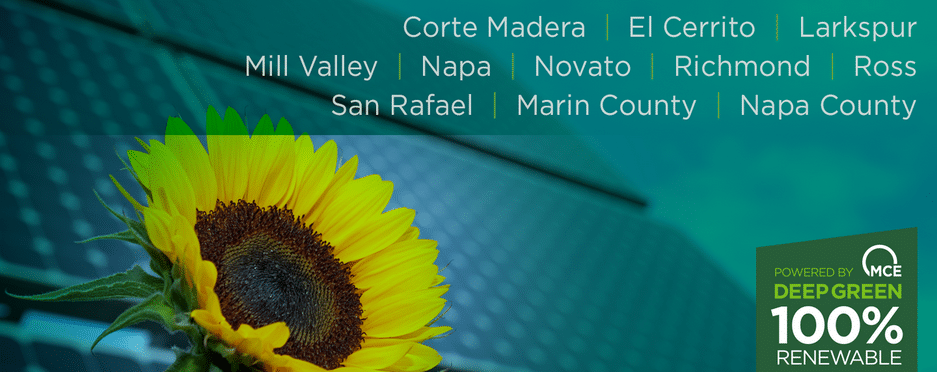In five years, as many as 60% of investor-owned utility (IOU) customers in California may be part of a community choice aggregation program (CCA). It all started with Marin Clean Energy (MCE), the state’s first CCA to set up shop back in 2010.
CCAs let communities procure renewable energy in bulk from developers, or build their own renewable energy projects. Electricity customers in the community can then get their energy from the CCA, instead of the utility, though the utility still maintains the grid and handles billing. The programs are opt-out, meaning customers are automatically enrolled in the basic program, which usually costs a bit less than electricity from the utility and provides a larger mix of clean energy. Customers can also “opt up” for an option that provides an even higher percentage of clean energy at a premium.
MCE’s Deep Green option offers 100% renewable energy for an additional 1 cent per kilowatt-hour.
In a surge of support that took place in just three months, 11 new communities have voted to enroll in Deep Green, which offers 100% wind and solar power produced in California. The Cities and Towns of Corte Madera, El Cerrito, Larkspur, Mill Valley, Napa, Novato, Richmond, Ross, and San Rafael, as well as the Counties of Marin and Napa, now join Belvedere, Fairfax, San Anselmo, San Pablo, and Sausalito, the first MCE municipalities to opt up.
That accounts for more than half of all MCE communities, and with this recent surge, MCE estimates that Deep Green electricity consumption will increase by 66% this year. By 2018, MCE expects to reach its goal of Deep Green making up 5% of its total electricity load, seven years ahead of its 2025 target.
J.R. Killigrew, Community Development Manager at MCE, said the recent sign-ons are the result of a grassroots community effort. While MCE worked with their contacts at the municipalities, they also partnered with local clean energy advocates to ensure the drive for opting up came from the community. The effort was bolstered by the climate action policies that the municipalities already had in place.
Despite the added cost of the Deep Green option, said Killigrew, the municipalities felt it was a cost-effective way to reduce their emissions. That’s especially true when the program is coupled with energy efficiency, which MCE encourages. The City of San Rafael, for example, was recently awarded a grant for low-interest financing of LED lighting retrofits that will decrease its power consumption.
Another selling point is that MCE invests half of its Deep Green revenue in local renewable energy projects. The City of Richmond, though not the most affluent in the MCE program, has been a leader in fighting climate change, and Mayor Tom Butt pointed out, “The premium from Deep Green helps fund projects like MCE Solar One, which will be the Bay Area’s largest publicly owned solar farm, supporting 341 jobs and generating enough power for 3,417 homes per year.”
With the added revenue coming in as more cities opt up, MCE is looking at building another project in the next few years. That’s a crucial element of the program. The lack of local build-out of clean energy projects in CCAs has been a critique from some advocacy groups, and a similar program being launched in nearby Alameda County aims to prioritize the development of local renewable energy resources.
Killigrew hopes that the momentum created by the recent municipal actions will be a springboard for further adoption of the Deep Green option, for both municipalities and individuals. Sometimes it’s just inertia that keeps customers from opting up, he noted, and for individuals the program is even more cost-effective, at about $4 – $10 a month.
This content is protected by copyright and may not be reused. If you want to cooperate with us and would like to reuse some of our content, please contact: editors@pv-magazine.com.








By submitting this form you agree to pv magazine using your data for the purposes of publishing your comment.
Your personal data will only be disclosed or otherwise transmitted to third parties for the purposes of spam filtering or if this is necessary for technical maintenance of the website. Any other transfer to third parties will not take place unless this is justified on the basis of applicable data protection regulations or if pv magazine is legally obliged to do so.
You may revoke this consent at any time with effect for the future, in which case your personal data will be deleted immediately. Otherwise, your data will be deleted if pv magazine has processed your request or the purpose of data storage is fulfilled.
Further information on data privacy can be found in our Data Protection Policy.